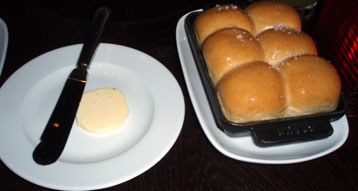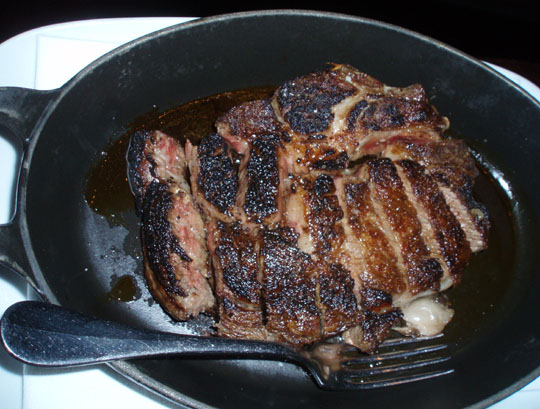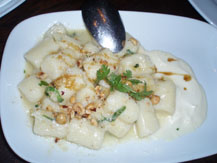

Interior shot (left); Chefs Marc de Canck and Olivier de Montigny (right)
My girlfriend and I spent a fun long weekend in Montreal last year. We enjoyed it so much that she suggested a return visit to celebrate my birthday. The question was: where to eat? Last time, we had a terrific meal at Toqué, and we wanted another meal in that class. An eGullet contributor suggested La Chronique.
The restaurant, located well apart from the central business district, occupies a fairly humble-looking space that belies the ambitious food. Belgian chef Marc de Canck has been at the helm since it opened in March 1995, joined more recently by his assistant Olivier de Montigny. It has garnered a mention in various international publications, including a favorable write-up from New York Times critic Eric Asimov in 1999.
The à la carte menu offers appetizers from CA$15–25 and entrées $34–45; there are only about half-a-dozen of each. We chose the seven-course degustation for $100 per person, with wine pairings another $50 or $100 (we had the latter). The explanations of the wines were unusually detailed, extending at times to full-blown tasting notes à la Wine Spectator.
I present the menu selections and paired wines below in French, followed in each case by our notes:


La mise en bouche en surprise du moment [above left]
La Lotte farcie de homard, crème de ptd et pois verts à la truffe [above right]
France, Saint-Aubin 1er Cru Les Frionnes, Hubert Lamy 2004
The amuse-bouche was a small daub of gravlax with crème fraîche. The first appetizer was a fairly complex presentation of monkfish stuffed with lobster, with a potato foam, green peas, and purple basil. The lobster had a nice sweeness, balanced by peach and almond notes in the paired wine.


Bar de ligne rôti, ravioli d’artichauts et sa vinaigrette tiède aux tomates séchées [above left]
France, Sancerre, Les Culs De Beaujeu, François Cotat 2005
La noix de ris de veau aux cèpes, foie gras et courge musquée [above right]
Amerique, Santa Rita Hills, Foley Pinot noir, Foley Estate 2005
Next came artichoke ravioli with red peppers and dried tomatoes, accompanied by the very smooth François Cotat Sancerre, which offered hints of grapefruit, green tea, aged in oak. I’m no great fan of artichokes, but I could appreciate the artistry of the dish.
After that, sweetbreads and foie gras in a chocolate and butternut squash purée. If you put so many ideas into one dish, the result could very well be mush. Instead, our note at the time was: “This is incredible.” The accompanying pinot noir offered hints of cherry and vanilla.


Le duo de boeuf Angus, endive caramélisée et girolles [above left]
Italie, Bolgheri, Ornellaia, Tenuta san Giudo 2002
Le plateau de fromages fermiers d’ici et d’ailleurs [above right]
Italie, Monferrato Rosso, Pin, La Spinetta 2003
The last savory course was a filet of black angus beef, with a braised beef tail, braised endive, onion, and veal jus. This seemed less memorable than some of the other dishes. The accompanying Italian wine came with a tasting note that almost defied detection by mere mortals: black olives, leather, plum, blackcurrant, strawberry, and cherries.
The server brought around a cheese platter, from which we chose six, all of which were wonderful, including a couple of unpasteurized cheeses that could not legally be served in the U.S.. The tasting note for the wine: tobacco, coffee, chocolate, red fruits, and blackcurrant.

La clafoutis aux pêches, caramel salé et glace vanille
France, Barsac-Sauternes 1er Cru, Château Climens 1995
Dessert was a light pastry with peaches, salted caramel, and vanilla ice cream, along with a sauterne. Tasting note: pineapple, mango, fig, and honey.
Service throughout was first-rate, and the timing of the courses—always tricky with a tasting menu—was just about right. The food at La Chronique has a bit less of the “wow” factor than at Toqué, but it must surely be one of the top handful of dining experiences in Montreal.
La Chronique (99 rue Laurier Ouest, Montreal)
Food: ***
Service: **½
Ambiance: **
Overall: **½
 Thursday, November 29, 2007 at 08:38AM
Thursday, November 29, 2007 at 08:38AM  Fabio Trabocchi,
Fabio Trabocchi,  Fiamma,
Fiamma,  Stephen Hanson in
Stephen Hanson in  BruniBetting
BruniBetting 






































